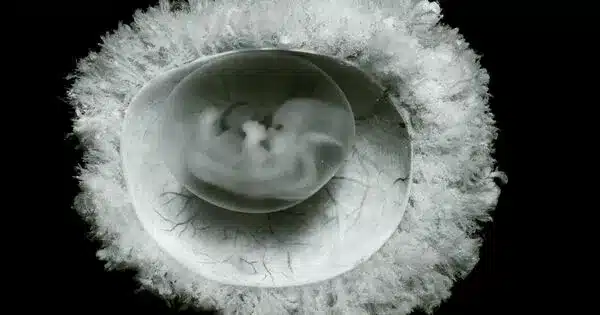Researchers report February 15 in the journal Cell that ancient viruses may be to thank for myelin — and, by extension, our large, complex brains. The team found that a retrovirus-derived genetic element or “retrotransposon” is essential for myelin production in mammals, amphibians, and fish. The gene sequence, which they dubbed “RetroMyelin,” is likely a result of ancient viral infection, and comparisons of RetroMyelin in mammals, amphibians, and fish suggest that retroviral infection and genome-invasion events occurred separately in each of these groups.
“Retroviruses were required for vertebrate evolution to take off,” says senior author and neuroscientist Robin Franklin of Altos Labs-Cambridge Institute of Science. “If we didn’t have retroviruses sticking their sequences into the vertebrate genome, then myelination wouldn’t have happened, and without myelination, the whole diversity of vertebrates as we know it would never have happened.”
Myelin is a complex, fatty tissue that ensheathes vertebrate nerve axons. It enables rapid impulse conduction without needing to increase axonal diameter, which means nerves can be packed closer together. It also provides metabolic support to nerves, which means nerves can be longer. Myelin first appeared in the tree of life around the same time as jaws, and its importance in vertebrate evolution has long been recognized, but until now, it was unclear what molecular mechanisms triggered its appearance.
Retrotransposons compose about 40% of our genomes, but nothing is known about how they might have helped animals acquire specific characteristics during evolution. Our motivation was to know how these molecules are helping evolutionary processes, specifically in the context of myelination.
Tanay Ghosh
The researchers noticed RetroMyelin’s role in myelin production when they were examining the gene networks utilized by oligodendrocytes, the cells that produce myelin in the central nervous system. Specifically, the team was investigating the role of noncoding regions including retrotransposons in these gene networks — something that hasn’t previously been explored in the context of myelin biology.
“Retrotransposons compose about 40% of our genomes, but nothing is known about how they might have helped animals acquire specific characteristics during evolution,” says first author Tanay Ghosh, a computational biologist at Altos Labs-Cambridge Institute of Science. “Our motivation was to know how these molecules are helping evolutionary processes, specifically in the context of myelination.”
In rodents, the researchers found that the RNA transcript of RetroMyelin regulates the expression of myelin basic protein, one of the key components of myelin. When they experimentally inhibited RetroMyelin in oligodendrocytes and oligodendrocyte progenitor cells (the stem cells from which oligodendrocytes are derived), the cells could no longer produce myelin basic protein.

To examine whether RetroMyelin is present in other vertebrate species, the team searched for similar sequences within the genomes of jawed vertebrates, jawless vertebrates, and several invertebrate species. They identified analogous sequences in all other classes of jawed vertebrates (birds, fish, reptiles, and amphibians) but did not find a similar sequence in jawless vertebrates or invertebrates.
“There’s been an evolutionary drive to make impulse conduction of our axons quicker because having quicker impulse conduction means you can catch things or flee from things more rapidly,” says Franklin.
Next, the researchers wanted to know whether RetroMyelin was incorporated once into the ancestor of all jawed vertebrates or whether there were separate retroviral invasions in the different branches. To answer these questions, they constructed a phylogenetic tree from 22 jawed vertebrate species and compared their RetroMyelin sequences. The analysis revealed that RetroMyelin sequences were more similar within than between species, which suggests that RetroMyelin was acquired multiple times through the process of convergent evolution.
The team also showed that RetroMyelin plays a functional role in myelination in fish and amphibians. When they experimentally disrupted the RetroMyelin gene sequence in the fertilized eggs of zebrafish and frogs, they found that the developing fish and tadpoles produced significantly less myelin than usual.
The study highlights the importance of non-coding regions of the genome for physiology and evolution, the researchers say. “Our findings open up a new avenue of research to explore how retroviruses are more generally involved in directing evolution,” says Ghosh.
















